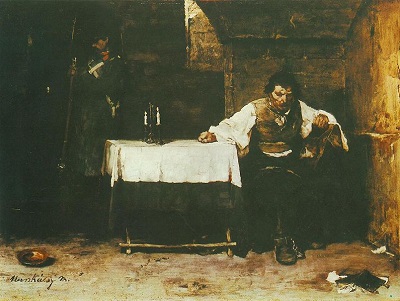
It’s been 40 years since the death penalty has been abolished in France. Far from the guillotine that ended Louis XVI’s life. Halfway across the world, in USA, it remains in force. American artists have created different artworks on the subject, with different perspectives. From Truman Capote to Metallica, the death penalty has been addressed by artists of all kinds, omniscient or not.
« Usually, death row is called The Last Mile. We called ours The Green Mile. The floor was the color of faded limes. We had the electric chair. » tells old Paul Edgecomb, main character of the movie The Green Mile (1999) by the american film director Frank Darabont. Played by Tom Hanks, Paul Edgecomb is an officer at Cold Mountain Penitentiary’s death row. One day, he encounters John Coffey (Michael Clarke Duncan), who is accused of killing two young sisters without evidence. The more time goes, the less the officer will be convinced of the guilt of the massive but shy black man. Almost all the staff of the penitentiary is going to cry the day of John’s execution, on the electric chair. The criticism is never frontal, but the vision is very binary. With the good and the evil, like Batman and The Joker. And the film is deeply anti death penalty. An observation which could be summarized by this quote pronounced by Paul Edgecomb : « Things that happen in this world. It’s a wonder God allows it. »
But John Coffey was resigned to die like Gary Gilmore, a criminal in real life who fascinated America, in
the novel The Executioner’s Song by Norman Mailer. Although on a different level. Because Gary
Gilmore literally forced his lawyers to stop fighting to save him. The Executioner’s song takes place in
Utah in the 70’s, when The Green Mile is in Louisiana. A territory that also inspired the American film
Dead Man Walking by Tim Robins. It’s about Matthew Poncelet who killed a young couple, but is helped
by the religious Sister Helen not to be executed. A position that the victim’s families won’t understand in
the movie.
The first non-fiction novel
And there will be many other victims in In Cold Blood by Truman Capote, the first non-fiction novel.
Published in 1966, it’s worthy of a thriller that even Agatha Christie couldn’t imagine. Indeed, in 1959 a
whole family is brutally killed in a Kansas farm. The young killers are Perry Smith and Dick Hickcock.
With modern prose, Truman Capote tells the consequences of those crimes. The writer has gathered the
confessions from the accused who were waiting in prison before death penalty was applied. Truman
Capote will admit he didn’t know anymore if he was a journalist or a writer at this time. But he will not
seek for objectivity and will stage himself, which is unusual for both professions.
Personally involved, he will make his own criticisms about death penalty when the American justice will
make the trial of ordinary violence. In his description of Perry’s execution, he claims that the investigator
kept his eyes closed until he heard the sound of the broken neck. Capote will put in parallel the
preventive effect of death penalty praised by the police with the investigator’s emotional reaction. By the
way, the writer himself has been traumatized by this story. He will sink into alcoholism as many dark
book characters, for example Jack Torrance in Stephen King’s The Shining. Capote’s best seller pretty
much cost him his mental health. At list, he popularized the theme of the news story in art. And even
today people are fascinated by serial killers all over the world, in the death row or not.
From Victor Hugo to Metallica
Music artists approached the death penalty too. As Victor Hugo in the novel The Last Day of a
Condemned Man, in the 80’s Metallica wrote the song Ride the Lightning in the first person, as if they
were a death row inmate. Who would have thought that politics would have bring a thesis novel and a
heavy metal song together ? Indeed, the american group explain the flaws that go with the capital
punishment. Some high notes are screamed. Probably to show the distress of the condemned man. But
in some interviews James Hetfield, singer and guitarist of Metallica, said that the goal of the song was
not to be critical.
And yet, with some lyrics we can see the question of legitimacy : “Strapped in the electric chair, this can’t
be happening to me. Who made you God to say « I’ll take your life from you ! »”. There’s also another
reference to religion : “Oh please God help me”. For a long time, Christians justified the death penalty
when nowadays the American Churches are mainly against the capital punishment. But today, 27 states
among the 50 federated states of the USA continue to apply the death penalty. Even if the American
society is very religious.


